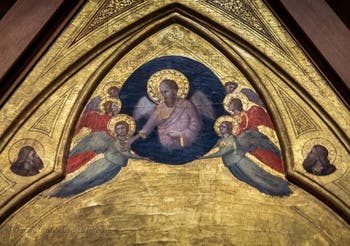Vatican Art Story | Location | Opening Hours Tickets | Authorisations
Art Story Sistine Chapel | Raphael | Caravaggio | da Vinci | Giotto | Sculptures | Van Gogh |
Giotto “Stefaneschi Triptych” Altarpiece at the Vatican Pinacoteca in Rome
Giotto di Bondone “Stefaneschi Triptych” Altarpiece
Painting - Tempera on Wood (223 x 255 cm) 1320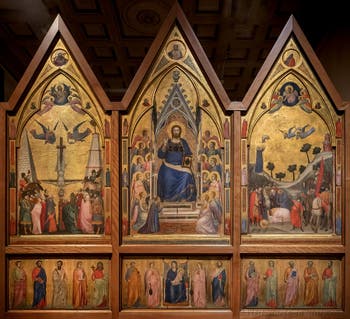
Verso of Stefaneschi Triptych The “Stefaneschi Triptych” by Giotto di Bondone (1267-1337), which can be admired at the Pinacoteca of the Vatican Museums, was located in the main altar of the first Basilica of Saint Peter, that of Constantine, where it preserved this place of honour until the reconstruction of the Basilica initiated in 1450.
The name of the triptych is linked to Cardinal Jacopo Caetani Stefaneschi, Giotto's protector, who commissioned most of his works from him, renowned for being one of the most critical art sponsors of the early 14th century.
As a donor, Stefaneschi is portrayed by Giotto on both sides of the central panels of the triptych.
On the back, he is kneeling and in humble clothes at the feet of Christ on the throne, while on the front, he appears wearing his cardinal garments at the feet of Saint Peter, offering him the Triptych of Giotto.
The Two Sides of Giotto's Stefaneschi Triptych
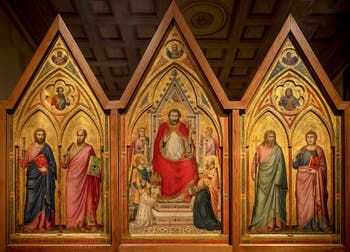
Recto of Stefaneschi Triptych This altarpiece is painted on both sides because its function is twofold.
On the one hand, he was facing the Pope when he attended the celebrations, sitting on his throne behind the altar as he should.
The front side of the Pope shows Saint Peter on the throne, with two saints represented in each of the panels surrounding the central panel.
The back side faced the apse and the faithful.
The back of Giotto's triptych, the one facing the believers, shows the “Blessing Christ” with the “Crucifixion of Saint Peter” on the left and the “Beheading of Saint Paul” on the right.
Giotto, the father of Renaissance art
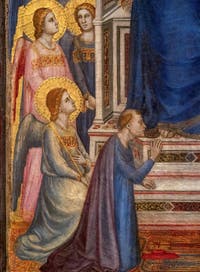
Cardinal Stefaneschi Giotto was one of the initiators of the Renaissance by being the first to free himself from the conformism and conventions of Greek and Italian-Byzantine styles.
Giotto thus marked the beginning of a new era in the history of painting.
By introducing depth into his paintings, Giotto ended the traditional representation of saints and figures in two dimensions.
This pictorial evolution is clearly evident in this triptych with the representation of the pavements and steps of the thrones, which create perspective and give depth to the various scenes in the altarpiece.
With the same intention, Giotto integrates landscape elements, trees and mountains, and architectural elements accentuating this depth effect.
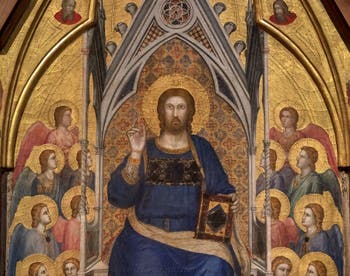
Stefaneschi Triptych, the Blessing Christ The other major revolution Giotto introduced involved humanising the characters by taking particular care of their faces, which, frozen in the Byzantine pictorial tradition, became lively and expressive by showing their emotions.
His Christ is no longer the conventional representation of an idea; he has become the embodiment of a historical fact.
His angels no longer correspond to traditional and preconceived representations; they are the image of a rational conception of a glorified humanity.
Her Madonna is no longer that supernatural being as found in Byzantine and Latin art; she is a very human mother with her divine child.
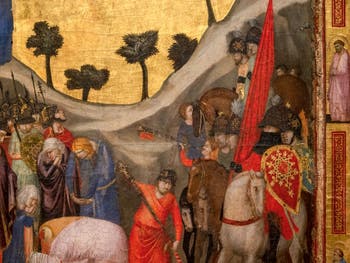
Beheading of Saint Paul Giotto's saints also break with the formal representations of ancient times and become living beings like us. Finally, Giotto introduces another major pictorial revolution: that of colour.
In Byzantine art, each colour had its own symbolic value.
Giotto decided to free himself from this constraint to use colour no longer on a symbolic level but on a spatial and volumetric level to accentuate the effects of perspective.
This is particularly the case with the Stefaneschi Triptych, where the tones' vibrancy and the cheerfulness resulting from their combinations illuminate the various scenes on the altarpiece panels as if the painter were happy to be able to reveal his discovery to us.
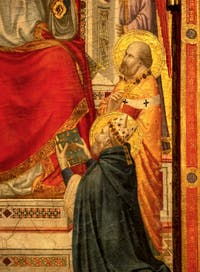
Detail of St Peter Through these three major pictorial innovations, perspective, humanisation, and colour, Giotto created the premises of Renaissance painting.
Giotto in Boccaccio's “Decameron”
The Florentine writer Boccaccio (1313-1375) praised Giotto in his “Decameron” as follows:
“Giotto was a genuine genius.
There was nothing in nature, the mother of all things, that Giotto, drawing and painting, could not reproduce with such fidelity that it not only looked like the original but could be mistaken for it.
Stefaneschi Triptych Giotto brought art back to light, an art that for centuries had remained buried under the mistakes of those who, in painting, thought more about pleasing the eyes of the ignorant than satisfying the intelligence of the wise.
Giotto can be said to have been one of the lights of Florentine glory.
A man who was also admirable and who, despite his fame, always knew how to remain humble by refusing to be called a master, he who was the master of all the others.”
Boccaccio, “Decameron” Day 6, New V (1353)
The “Crucifixion of Saint Peter” or the “Martyrdom of Saint Peter” by Giotto
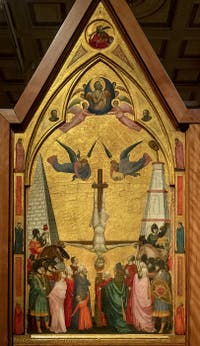
Crucifixion St Peter This panel from the Stefaneschi Triptych shows us Saint Peter crucified upside down with an attitude of firmness in the face of death: his face does not show his pain.
We also note that Giotto makes no error in proportion when showing the naked body of Saint Peter and the effect of gravity on this suspended body.
A woman hugs the cross while others cry around the saint or accompany her soul to the Lord, like the woman wearing a green coat with her arms wide open and hair loose.
Pain and horror are also represented in the attitude of the child Giotto shows turned backwards.
Saint Peter is crucified between a pyramid and a tower; these two monuments indicate the place of torment.
Saint Peter was martyred in the Circus of Nero, which was right next to the current location of Saint Peter's Basilica in the Vatican.
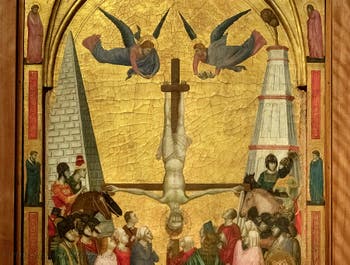
Crucifixion St Peter In Nero’s Circus, during chariot races, the chariot veered at each end of the track around the pyramid on one side and the tower on the other.
These two architectural elements shown here are particularly well-treated and add to the perspective effect sought by Giotto.
Giotto also successfully manages the crushing effect that could have been generated by the double horizontal line created by the ground and the crossbar.
To do this, he uses the crowd at the feet of Saint Peter by creating a curve in which he supports the figures riding on the pyramid and the tower, allowing these same riders to transmit visual stability to these architectural elements.
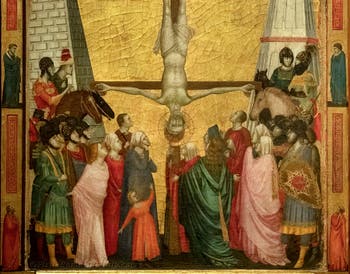
Crucifixion St Peter To complete his curve effect, Giotto deliberately features characters of different sizes, an element further accentuated by the presence of the child highlighted by the orange colour of his tunic.
We will also note the use that Giotto makes of colours to accentuate his curve through the different shades of the characters' clothes: pink, red, and green, as well as the use of orange in the lower edge of the tunics of the two soldiers framing the scene, a colour that he repeats for their boots.
This treatment of colours and shapes allows Giotto to harmonise with this crowd while diversifying and structuring it.
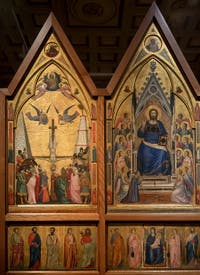
Stefaneschi Triptych Two angels, with wings outstretched and fluttering clothes, fly quickly towards Saint Peter, one with an open book and the other with his hands clasped together.
Above, we see the soul of Saint Peter rising, carried to heaven by six angels.
Finally, at the tip of the panel, here is Abraham raising his sword, ready to perform the sacrifice of his son Isaac. The art of composition and the pathetic feeling expressed in this panel reveal the genius of Giotto and show his advance over his time.
Because this is a real difficulty for a painter of the time to overcome: what are the artistic possibilities in representing a crucified man upside down?
Giotto overcomes this difficulty by transmitting the spiritual inspiration of the scene by communicating through this work the virtues of patience, humility and suffering.
The “Beheading of Saint Paul” or “Martyrdom of Saint Paul” by Giotto
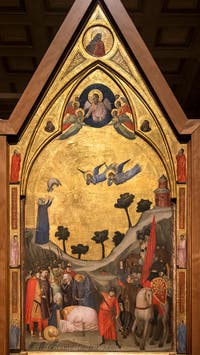
Beheading of Saint Paul In designing the back of his triptych, Giotto faced another difficulty.
How to create a sufficiently powerful composition of the beheading of Saint Paul while unifying and balancing it harmoniously with the “Crucifixion of Saint Peter” while maintaining sufficient contrast with the central subject of “Christ in the Throne”.
To do this, Giotto uses the golden background of the scene, which is repeated at the same level and in the same proportions on both panels, the two gold funds referring to each other.
Similarly, the curve created by the crowd of characters from the “Crucifixion” is repeated in the “Decapitation” with the introduction of a mountainous landscape.
To accentuate the visual effect of the curve in the “Decapitation”, Giotto echoes the pyramid and the tower of the “Crucifixion” by including on the left a woman who received a veil thrown by the apostle during her ascent and, on the right, another tower representing the prison of Saint Paul.
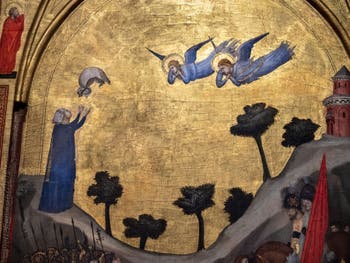
Beheading of Saint Paul This woman refers to the pity of Plautilla, a Roman noblewoman who had lent her veil to Saint Paul to blindfold him during his execution; the saint had promised to return it after his death.
To be able to introduce this miraculous event into his painting, Giotto, therefore, had to present the beheading of Saint Paul as having already been carried out since the miracle can only be after this one.
We also note that Giotto refused to show all the horror of this beheading.
Of course, we cannot escape the blood that flows from the apostle's body.
Still, the head of Saint Paul, which has rolled on the ground, is presented supernaturally, with its face turned towards the sky and surrounded by gold, lying where, according to legend, three springs sprung; this partly mitigates the monstrosity of the scene.
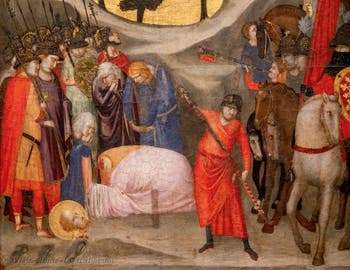
Beheading of Saint Paul We even feel a form of tenderness about the “Crucifixion of Saint Peter” with these three women leaning on the saint's body.
This compassion can also be seen on the pensive face of the man behind the kneeling woman.
Behind them, a group of soldiers on horseback and on foot armed with spears while in the foreground, the executioner, indifferent, holds out his bloody sword; work done!
The right of the painting is occupied by another group of soldiers on horseback, including a white horse and two other horses who look the other way, absent and innocent of the horrible act in front of them.
The body of Saint Paul is picked up, kneeling with hands clasped in prayer.
The rapid descent of the angels above the landscape contrasts with the serenity of the six others who, on the cusp, ascend to heaven carrying Saint Paul.
Giotto, Stefaneschi Triptych, the “Blessing Christ” or “Christ in Majesty”
The “Blessing Christ” sign is at the centre of the back of the Stefaneschi Triptych, facing the believers.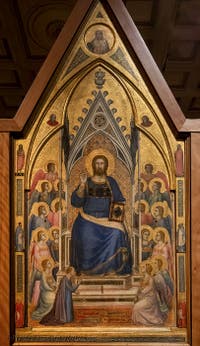
The Blessing Christ Christ and the angels have expressive attitudes and faces that contrast with the Latin-Byzantine style still in force at the time.
The Byzantine tradition is nevertheless well integrated into the scene, but Giotto successfully humanises it.
A large Christ on the throne dressed in blue is surrounded by a double row of angels.
At the bottom left, we can see the sponsor of the painting, Cardinal Stefaneschi, dressed simply, kneeling in an attitude of humility, ready to kiss his foot.
Christ blesses with one hand while with the other, he holds the book of the Holy Scriptures lying on his knee.
This panel from the Giotto Triptych is particularly well highlighted by its central position, which is essential given the subject, the dark blue colour of Christ's tunic, but also thanks to the two panels of the “crucifixion” and “decapitation” scenes that frame it.
The front side of Giotto's Stefaneschi Triptych: “Saint Peter on the throne and four saints.”
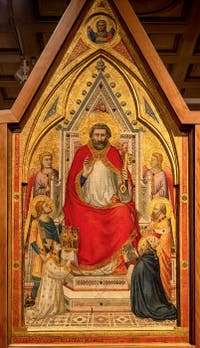
Saint Peter on throne The front of the triptych was not visible to the faithful but only to the Pope and the prelates who surrounded him during the celebration of Mass in Saint Peter's Basilica.
The central panel portrays “Saint Peter the Blessing” on a throne. Giotto painted it on the opposite side of the “Blessing Christ” which is obviously addressed to the successors of the builder of the Church of Christ.
Saint Peter is represented in a papal uniform with the keys in his left hand while he blesses with his right one.
Saint Peter is surrounded by two angels and two holy apostles on each side panel: Saint James and Saint Paul in the left panel and Saint Andrew and Saint John in the right panel.
It should be noted that the saints on the side panels and Saint Peter are the same size, while the saints at his feet are of reduced size, especially with regard to Cardinal Stefaneschi, who is presented to Saint Peter by Saint George.
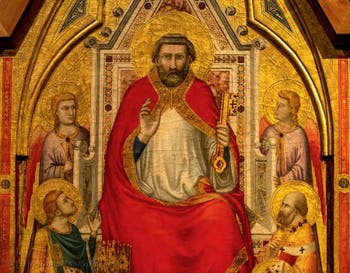
Saint Peter on throne The hierarchy is respected!
The sponsor of the triptych is on his knees, this time in formal clothing, and he offers the father of the Church Giotto's altarpiece, which shows the scene on the front side that we have in front of us.
This front side of Giotto's triptych is absolutely superb; all the painter's genius can be found here: harmony, the power of drawing and colours.
The steadfastness of Saint Peter is seen in his impassive face, which expresses all his religious concentration.
The Predellas from the “Stefaneschi Triptych” by Giotto
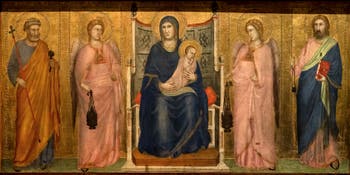
Virgin Mary and Child Jesus on the throne Three predellas are present under the panels on the back of the altarpiece.
They represent the Virgin Mary and the Child Jesus on the throne, surrounded by two angels and the twelve apostles.
Giotto represented the Madonna just below Christ's blessing on the top panel.
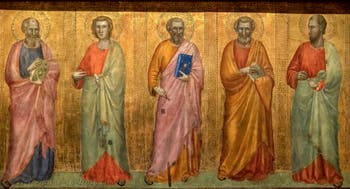
Predella of Apostles Her dark blue dress echoes the colour of Christ's tunic and connects Jesus to his mother.
The Infant Jesus and the Virgin Mary were humanised by Giotto and broke with the usual representations of Latin-Byzantine art.
She holds Jesus as a mother, even if Giotto has retained the dignity of his rank for her.
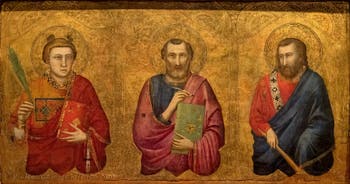
Saint Peter, Saint Stephen and Saint Bartholomew The same humanity is found in the Child Jesus, who sucks his fingers and whose face is no longer that of traditional figures in which Jesus is a supernatural child who already looks like an adult.
We will also note the humanity of the angels surrounding the throne who gently swing their incense burners while keeping their eyes tenderly fixed on the Child Jesus.
The Predella on the Front of Giotto's Stefaneschi Altarpiece
On the front side of the altarpiece, on the Pope's side, only one predella is still present; the other two were probably lost or destroyed after the reconstruction of Saint Peter's Basilica.It presents the busts of Saint Peter, Saint Stephen and Saint Bartholomew.
Art Story Sistine Chapel | Raphael | Caravaggio | da Vinci | Giotto | Sculptures | Van Gogh |
Vatican Art Story | Location | Opening Hours Tickets | Authorisations
Back to Top of Page


